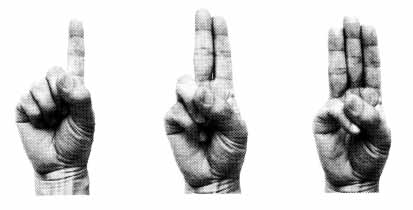Everyone (who can count) will instantly recognise the numbers 1 2&3 in the picture below:
Or will they? Well, no they won’t.

All is explained in an article for Osaka Keidai Ronshu, Vol. 60 number 5, where Professor Yutaka Nishiyama (Osaka University of Economics, Japan) lists many crucial variations in finger-counting across the world.

These hands, for example, also show the numbers 1, 2 &3 – as will be readily appreciated by those from India, Pakistan and Bangladesh. The professor has discovered (via the internet) that there are at least 27 types of finger-counting regimes across the world. But how could so many variations come about? The professor gives examples – Europe for instance :
“Meals in Europe involve a knife and fork. When cutting meat it is necessary to firmly grasp the knife and fork. When so doing, it is the thumb which is free to move. So is this why extending the thumb came to represent 1?”
and in Africa :
“There are also tribes that have adopted base 20, Perhaps this owes to the fact that a barefooot lifestyle makes the toes available for use too.”
The professor’s paper, ‘Counting with the fingers’ can be read in full here
Previous research from the professor here (Why eggs aren't round)




Comments